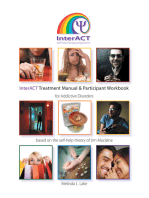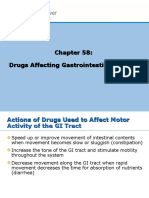Chapter 7 Individual Treatment
Chapter 7 Individual Treatment
Uploaded by
Cory HarnessCopyright:
Available Formats
Chapter 7 Individual Treatment
Chapter 7 Individual Treatment
Uploaded by
Cory HarnessOriginal Description:
Copyright
Available Formats
Share this document
Did you find this document useful?
Is this content inappropriate?
Copyright:
Available Formats
Chapter 7 Individual Treatment
Chapter 7 Individual Treatment
Uploaded by
Cory HarnessCopyright:
Available Formats
Chapter 7 Individual Treatment
In the past when a person was wanting to attend substance abuse treatment they will be given 28 days
inpatient and an unlimited amount of time for outpatient therapy. Due to changes in the way insurance
work, this is no longer the case. An individual must get prior approval for treatment prior to entering an
inpatient rehab facility and the stay substantially less. Due to this change it is important for the therapist
to change their treatment plans to make sure they can provide the most amount of help in a shorter
amount of time. Treatment for substance abuse has shown to be more affective when the therapist
combines individual therapy, group therapy and family therapy into the treatment plan.
1. Beginning Individual Treatment
a. Believed that an individual who is going through substance abuse has formed an
emotional attachment to their drug of choice and will go through grief and loss when
they discontinue using the substance.
b. According to DiClemte there are five stages of change that an individual who uses
substances goes through.
i. Pre-contemplation (Not considering Change)
ii. Contemplation (Weighs all options for change and possible ambivalent)
iii. Preparation (Trying to Change
iv. Action (Changing behaviors)
v. Maintenance (Commitment and planning)
c. In order for change to be effective the individual must be in stage three prior to starting
treatment.
d. According to ASAM there are four different levels of treatment that an individual may
participate in:
i. Outpatient
ii. Intensive Outpatient and partial hospitalization program
iii. Medically monitored impatient (residential) treatment
iv. Medically manage impatient treatment
e. The level of treatment that a person receives is determined by the insurance company.
2. Interventions
a. can happen in many ways
b. Will typically include all significant members of the individuals life.
c. In order to complete and intervention successfully they need to be structured to
acknowledge the care and concern for the abuser but also needs to stress that the
continued abuse has both limits and significant consequences.
d. An intervention can be done without a substance abuse therapist involved
i. But do the level of emotional intensity it is recommended that a substance
abuse therapist be involved to assist with the planning of the intervention and
be present to supervise.
e. It is important to remember that even though there is conflict accruing during the
intervention that there should be no malice.
f. It is also important to have a group of individuals preform the intervention versus a
single individual.
i. Because it is harder for the individual to brush off his/her behavior and actions if
they are being held accountable to more than one person.
3. Ethical Concerns
a. The most important thing the therapist needs to remember prior to starting the
intervention is that everybody has rights and they need to be made aware of those
rights prior to the start of the intervention.
4. Therapeutic Alliance
a. It is important for the therapist to have a therapeutic alliance with their client in order
for therapy to be affective.
i. Listening to the individual without passing judgment verbally or nonverbally
ii. Validation
iii. Nonverbal communication and positive regard
iv. Language used by the counselor to create motivation toward behavior change
5. Direct Effect Strategies
a. Motivational Interviewing
i. Client Centered and directive
ii. Two main goals
1. Move the ATOD individual in a direction of making a positive change
toward recovery
2. Resolve ambivalence by increasing internal motivation and increasing
self-efficacy
b. Five principles
i. Express empathy
ii. Roll with resistance
iii. Develop discrepancy
iv. Support self-efficacy (Gaining confidence in ones self). Is necessary for therapy
to be successful and should be stressed at the beginning of therapy.
v. Avoid argumentation
c. Success of MI in relies heavily on the language of the therapist
i. Change Talk (the individual expresses the benefit for change and the hope for
change in the future)
ii. Therapist who use change talk have showed better sobriety outcomes.
iii. Techniques used to elicit change talk
1. Exploring the addiction
2. Examining past experiences
3. Looking forward to recovery and setting positive treatment goals
4. Examining values along with behavior
5. Identifying the positives and negatives of the current decision to change
6. Planning and committing to change
d. Cognitive-Behavioral Therapy
i. One of primary techniques is self-control
ii. According to the national institute on drug abuse and individual who abuses
substances must change behavior by first altering his/her thinking or frame of
reference.
iii. Some individuals use substances as a coping mechanism and CBT can be used to
teach those new coping skills and strategies to prevent relapse.
iv. CBT can be used in conjunction with Mindfulness
e. Mindfulness Technique
i. moment to moment non-judgmental awareness cultivated by paying attention
in a specific way, that is, in the present moment, and as non-judgmentally and
openheartedly as possible
ii. Individual learns through the therapist language to live in the moment of the
experience by using all senses.
iii. Participates are required to focus on a certain part of the body and meditate
which allows them to regulate their thoughts
iv. Can be used in all levels of treatment
v. Shown to be more effective then CBT in reducing the patients response to
psychological and physiological stressors
f. Pharmacotherapy
i. Should be used in conjunction with individual therapy
ii. Can be used in two ways
1. Safely withdraw from a substance (Detoxification)
a. Heroin: methadone, and sometimes also clonidine
b. Alcohol: benzodiazepine, or Phenobarbital (eases the
discomfort of withdraw and reduces the chances of seizures)
2. Prevent relapse
a. Disulfiram has been shown to be effective individuals with
alcohol dependency, cocaine dependency, and both.
i. Alcohol: Causes the individual to become violently ill
when they drink
ii. Cocaine: Helps reduce cravings
b. Acamprosate calcium (Campral) shown to be effective with
treating alcohol dependency
c. Subxone can be used with the opiate population and is safe for
pregnant women
d. Buprenorphine can also be used with the opiate population
3. Combination of individual and group therapy and self-help is
recommended as an adjunct to medication.
2. Broad Spectrum Strategies
a. Purpose of these strategies is to incorporate them into individual treatment and to
approach the client holistically while addressing concerns that could hinder individual
treatment.
b. Harm Reduction
i. Overall goal is to assist the individuals to identify coping strategies when faced
with harmful events and reduce risky behavior.
ii. Includes education about the drug of choice along with therapy to encourage a
decision in favor of abstaining or reducing harm.
iii. Meet the client where theyre at.
iv. Should set short term goals not long term goals
v. Long term goals can do more harm than good.
vi. Can be used in conjunction with motivational interviewing, CBT, and Solution
focused counseling.
c. Coping skills training/Life skills training
i. Some addicts have not learned social skills or have lost the ability to use them
due to drug addiction.
ii. Important to teach social skills during therapy
1. Modeling
2. Role play
3. Demonstration
d. Vocational Readiness
i. Research showed that an individual is more likely to succeed in recovery if they
are gainfully employed
ii. In 2008 it was shown that 78% of treatment facilities do not conduct vocational
assessments and did not provide vocational counseling as a standard practice
iii. Success of maintaining recovery relies heavily on the substance abusers ability
to work and to fill the day with positive activities
iv. Working becomes a self-fulfilling activity
e. Support Groups
i. 12-step self-help group such as NA, AA, and CA
ii. Help individuals with developing a clean and sober social network
iii. Should be used as a supplement to individual therapy
iv. Help to motivate the individual to be clean and sober
v. Provide peer support
vi. Provide goal direction, social values that are positive,
1. Encouraging strong bonds with family, friends, work and spirituality
vii. Can also be found online if face-to-face group is not available or preferred
viii. Utilization of self-help groups and spirituality with the development of self-
efficacy can lead to self-actualization, which allows the individual to be self-
aware of his/her ability as well as potential and take personal responsibility for
recovery.
You might also like
- Pharmacy DC Pharmacy Laws and RegulationsDocument430 pagesPharmacy DC Pharmacy Laws and RegulationsTanganGondrongNo ratings yet
- Pre Post TestDocument4 pagesPre Post TestRain0% (1)
- Marie Curie Biography For KidsDocument4 pagesMarie Curie Biography For KidsIntan NisitaNo ratings yet
- Cns 765 Case Study FinalDocument10 pagesCns 765 Case Study Finalapi-582911813No ratings yet
- The Prevalence of Substance Use and Other Mental Health Concerns Among American AttorneysDocument7 pagesThe Prevalence of Substance Use and Other Mental Health Concerns Among American AttorneysDavid AndreattaNo ratings yet
- William Glasser Reality TherapyDocument4 pagesWilliam Glasser Reality Therapynaim_mahadi_1100% (1)
- Healing From The SourceDocument4 pagesHealing From The SourceAngelo de MijasNo ratings yet
- Interact Treatment Manual & Participant Workbook: Based on the Self Help Theory of Jim MaclaineFrom EverandInteract Treatment Manual & Participant Workbook: Based on the Self Help Theory of Jim MaclaineNo ratings yet
- Interventions For Families of Substance AbuseDocument7 pagesInterventions For Families of Substance Abuseapi-284406278No ratings yet
- Wrap (Wellness Recovery Action Plan) Western AustraliaDocument4 pagesWrap (Wellness Recovery Action Plan) Western AustraliagavinbuzzNo ratings yet
- Substance Use Prevention in The United StatesDocument6 pagesSubstance Use Prevention in The United Statesjackson maunduNo ratings yet
- 7teste Gramatica RomanaDocument37 pages7teste Gramatica RomanaStacia CunninghamNo ratings yet
- Self-Development Groups Among Women in RecoveryDocument9 pagesSelf-Development Groups Among Women in RecoveryPaula FariaNo ratings yet
- A Reading On Substance Abuse and Nursing - Patient InteractionDocument10 pagesA Reading On Substance Abuse and Nursing - Patient InteractionyuviebNo ratings yet
- Narcotics Anonymous Meeting 3Document6 pagesNarcotics Anonymous Meeting 3api-401390929No ratings yet
- Midyear Training CADCA MYTI14 - Program - FinalDocument48 pagesMidyear Training CADCA MYTI14 - Program - FinalRuss BelvilleNo ratings yet
- Substance DisorderDocument63 pagesSubstance DisorderBagus Cahya WibawaNo ratings yet
- Background PaperDocument36 pagesBackground PaperSaad MotawéaNo ratings yet
- 03 Psycheck Clinical TreatmentDocument147 pages03 Psycheck Clinical TreatmentJohnny TorresNo ratings yet
- Adolescent Substance AbuseDocument46 pagesAdolescent Substance AbusesamuelNo ratings yet
- Discussions Both ClassesDocument3 pagesDiscussions Both ClassesPatrick KorNo ratings yet
- Drug AddictionDocument15 pagesDrug Addictionapi-300158819No ratings yet
- SW 3020 Biopsychosocial Paper 1-Anika-LaptopDocument19 pagesSW 3020 Biopsychosocial Paper 1-Anika-Laptopapi-282542988100% (1)
- Mental Health & Substance Abuse Drug Abuse Monitoring SystemDocument29 pagesMental Health & Substance Abuse Drug Abuse Monitoring SystemRavi Gaura Das100% (1)
- Schizophrenia Spectrum and Other Psychotic DisordersDocument41 pagesSchizophrenia Spectrum and Other Psychotic DisordersNoelle Grace Ulep BaromanNo ratings yet
- Essential Skills For Case ManagersDocument11 pagesEssential Skills For Case ManagersM A Jaya DamanikNo ratings yet
- Substance Abuse BrochureDocument2 pagesSubstance Abuse Brochureapi-272566401No ratings yet
- Guia Opiodes PDFDocument356 pagesGuia Opiodes PDFkarlunchoNo ratings yet
- PAws Samsha PDFDocument8 pagesPAws Samsha PDFAnonymous JS9PXY2100% (1)
- Sud WomenDocument61 pagesSud WomenJennifer Delgado CabánNo ratings yet
- Na ReflectionDocument6 pagesNa Reflectionapi-433710976No ratings yet
- How Do Genes Affect AddictionDocument7 pagesHow Do Genes Affect AddictionIvy Maril De GuzmanNo ratings yet
- Monroe Co. Mental Health and Substance Use Disorder 90-Day Task Force Final ReportDocument78 pagesMonroe Co. Mental Health and Substance Use Disorder 90-Day Task Force Final ReportPatrick Crozier50% (2)
- Research PaperDocument16 pagesResearch Paperapi-559296640No ratings yet
- Chem Dep Family ReadingDocument1 pageChem Dep Family ReadingDawn FarmNo ratings yet
- The Matrix Model in Outpatiens Substances AbuseDocument9 pagesThe Matrix Model in Outpatiens Substances AbuseEduardo Garza GarzaNo ratings yet
- Hildegard Peplau's Interpersonal Relations 101Document88 pagesHildegard Peplau's Interpersonal Relations 101Ynaffit Alteza UntalNo ratings yet
- Integrated Group Treatment For People Experiencing Mental Health-Substance Use Problems, Kathleen SciaccaDocument14 pagesIntegrated Group Treatment For People Experiencing Mental Health-Substance Use Problems, Kathleen SciaccaKathleen Sciacca, MA - Sciacca Comprehensive Service Dev. Dual Diagnosis; Motivational Interviewing100% (1)
- Ic - Group Case ConceptualizationDocument12 pagesIc - Group Case Conceptualizationapi-239581082No ratings yet
- MI Change PlanDocument3 pagesMI Change Planeclatant100% (1)
- Mental Health Lesson PlanDocument4 pagesMental Health Lesson Planapi-533004402No ratings yet
- Professional Disclosure Statement FinalDocument6 pagesProfessional Disclosure Statement Finalapi-661682802No ratings yet
- Sberna Angela NicoleDocument24 pagesSberna Angela NicoleawangbokNo ratings yet
- DAST Questionnaire - DRUG ABUSEDocument1 pageDAST Questionnaire - DRUG ABUSErichieerishi100% (1)
- Continuum of Substance UseDocument31 pagesContinuum of Substance UseDrSnipes100% (5)
- Journal PromptsDocument1 pageJournal PromptsnettextsNo ratings yet
- TADCP 9th Annual Drug Court Conference AgendaDocument15 pagesTADCP 9th Annual Drug Court Conference AgendatadcpNo ratings yet
- Prevention Treatment and Care StimulantsDocument76 pagesPrevention Treatment and Care StimulantsErnesto CortésNo ratings yet
- A "Love Letter" From Our Addiction:: (See All Authors)Document2 pagesA "Love Letter" From Our Addiction:: (See All Authors)ObyNo ratings yet
- Coun 541 Theoretical Orientation PaperDocument9 pagesCoun 541 Theoretical Orientation Paperapi-696100484No ratings yet
- Naadac Nccap Code of Ethics11!04!16Document21 pagesNaadac Nccap Code of Ethics11!04!16PrayudaSaidNo ratings yet
- Bio-Psycho-Social Assessment Part A B Final Paper SW 3020Document13 pagesBio-Psycho-Social Assessment Part A B Final Paper SW 3020api-319252753No ratings yet
- Primary Prevention 17Document109 pagesPrimary Prevention 17melodyfathiNo ratings yet
- Recovery: Morning Report 21 Okt 2013Document12 pagesRecovery: Morning Report 21 Okt 2013fiddina mediolaNo ratings yet
- Needs Assessment - Catskills Addiction Coalition PDFDocument108 pagesNeeds Assessment - Catskills Addiction Coalition PDFJulia ReischelNo ratings yet
- Reading On Substance Abuse-MataDocument13 pagesReading On Substance Abuse-MataNicole Keesha MataNo ratings yet
- Decriminalization in BC: S.56 (1) ExemptionDocument44 pagesDecriminalization in BC: S.56 (1) ExemptionCTV VancouverNo ratings yet
- Group Therapy PDFDocument2 pagesGroup Therapy PDFma maNo ratings yet
- Cognitive Behavior Therapy 0Document53 pagesCognitive Behavior Therapy 0Mirela Cojocaru StetcoNo ratings yet
- RA 3720 - Foods, Drugs Devices and Cosmetic ActDocument47 pagesRA 3720 - Foods, Drugs Devices and Cosmetic ActJohnny Manahan100% (2)
- Anatomy Liver FlukeDocument3 pagesAnatomy Liver Flukeapi-295865391No ratings yet
- Monteggia Fractures - Pearls and PitfallsDocument9 pagesMonteggia Fractures - Pearls and PitfallsdrdabielmaderacNo ratings yet
- Metro Manila Developmental Screening Test FinDocument27 pagesMetro Manila Developmental Screening Test FinYana PotNo ratings yet
- Motion To Limit or Exclude Specific Opinions or Testimony of Dr. James OrrDocument64 pagesMotion To Limit or Exclude Specific Opinions or Testimony of Dr. James OrrDentist The MenaceNo ratings yet
- CANS-MH Manual PDFDocument35 pagesCANS-MH Manual PDFparaypanNo ratings yet
- Paracetamol ElixirDocument16 pagesParacetamol ElixirKen LaguiabNo ratings yet
- 10th World Veterinary Dental Congress 2007 BrazilDocument127 pages10th World Veterinary Dental Congress 2007 BrazilHumberto FustesNo ratings yet
- Tumor Laring LaringDocument4 pagesTumor Laring LaringGhea GestivaniNo ratings yet
- Cardio Pulmonary ResuscitationDocument13 pagesCardio Pulmonary Resuscitationaparna100% (1)
- Pityriasis Alba: Are You Confident of The Diagnosis?Document3 pagesPityriasis Alba: Are You Confident of The Diagnosis?freska ayu wardhaniNo ratings yet
- CARLADocument2 pagesCARLACarla RPhNo ratings yet
- colonoscopy procedureDocument4 pagescolonoscopy procedurealorillaNo ratings yet
- Effective Birth Preparation BookDocument299 pagesEffective Birth Preparation BookRoxana100% (1)
- ScriptDocument4 pagesScriptMik ChezkaNo ratings yet
- Pemphigus VulgarisDocument3 pagesPemphigus VulgarisAdib MuntasirNo ratings yet
- Drugs Affecting Gastrointestinal Motility Drugs Affecting Gastrointestinal MotilityDocument34 pagesDrugs Affecting Gastrointestinal Motility Drugs Affecting Gastrointestinal MotilityJojo JustoNo ratings yet
- Cardiac Glycosides 815Document19 pagesCardiac Glycosides 815SanskritiNo ratings yet
- Air Liquide Clarys 2000 Medical TaemaDocument2 pagesAir Liquide Clarys 2000 Medical TaemaAbdelkarim RahmaniNo ratings yet
- Hemodynamics in The Cath Lab 2Document45 pagesHemodynamics in The Cath Lab 2usfcards100% (1)
- Pharm DDocument9 pagesPharm DHesham IbrahimNo ratings yet
- Diatomaceous Earth General Fact SheetDocument3 pagesDiatomaceous Earth General Fact SheetdoggydogNo ratings yet
- Development and Validation For Simultaneous Estimation of Cefuroxime Axetil and Linezolid in Bulk Drug and Pharmaceutical Dosage Form by RP - HPLCDocument5 pagesDevelopment and Validation For Simultaneous Estimation of Cefuroxime Axetil and Linezolid in Bulk Drug and Pharmaceutical Dosage Form by RP - HPLCBaru Chandrasekhar RaoNo ratings yet
- The 5% That Went To GAD: By: Atty. Joanne RanadaDocument14 pagesThe 5% That Went To GAD: By: Atty. Joanne RanadaJuadjie ParbaNo ratings yet
- Certification in PhlebotomyDocument2 pagesCertification in PhlebotomyBrian KingNo ratings yet
- Misc Protocols Acu PDFDocument136 pagesMisc Protocols Acu PDFFarooq Bin Mahfooz100% (2)
- Library SkillsDocument3 pagesLibrary SkillsMelba O. CruzNo ratings yet

























































































